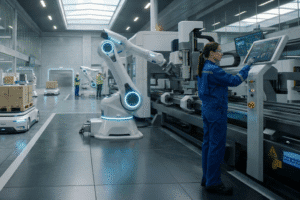- Services
Technology Capabilities
Technology Capabilities- Product Strategy & Experience DesignDefine software-driven value chains, create purposeful interactions, and develop new segments and offerings.
- Digital Business TransformationAdvance your digital transformation journey.
- Intelligence EngineeringLeverage data and AI to transform products, operations, and outcomes.
- Software Product EngineeringCreate high-value products faster with AI-powered and human-driven engineering.
- Technology ModernizationTackle technology modernization with approaches that reduce risk and maximize impact.
- Embedded Engineering & IT/OT TransformationDevelop embedded software and hardware. Build IoT and IT/OT solutions.
- Industries
- GlobalLogic VelocityAI
- Insights
BlogsDecember 16, 2024Gene LeybzonAccelerating Digital Transformation with Structured AI Outputs
This code produces the following output that can be imported into the candidate trackin...
 BlogsOctober 30, 2024Yuriy Yuzifovich
BlogsOctober 30, 2024Yuriy YuzifovichAccelerating Enterprise Value with AI
Discover how financial services integrations are transforming from standalone offerings...

- About Us
Press ReleaseGlobalLogicSeptember 23, 2025Hitachi agrees to acquire German data and AI services firm ...
Strengthening GlobalLogic’s data and consulting capabilities and expanding footprint in...
 Press ReleaseGlobalLogicSeptember 10, 2025
Press ReleaseGlobalLogicSeptember 10, 2025GlobalLogic and Ericsson Deploy Private 5G Network at Hitachi ...
The new infrastructure is the digital backbone of the Hagerstown plant, enhancing effic...

- Careers
Published on November 11, 2025The Agent as Gatekeeper: How AI is Remaking the Path from Buyer to Brand
View all articles Yuriy YuzifovichChief Technology Officer, AIShareRelated Content
Yuriy YuzifovichChief Technology Officer, AIShareRelated Content GlobalLogic18 December 2025
GlobalLogic18 December 2025 GlobalLogic1 December 2025View All Insights
GlobalLogic1 December 2025View All Insights GlobalLogic27 November 2025Recommended authorsDirector, Industrial BU GSPSenior Vice President & Head of EMEAView all authorsVice President & Consumer Business, Americas GlobalLogic
GlobalLogic27 November 2025Recommended authorsDirector, Industrial BU GSPSenior Vice President & Head of EMEAView all authorsVice President & Consumer Business, Americas GlobalLogicLet's start engineering impact together
GlobalLogic provides unique experience and expertise at the intersection of data, design, and engineering.
Get in touchAgentic AIEnterprise AICross-IndustryRetail and ConsumerCommerce has entered a new phase: intelligent, autonomous, and always on. With the official AP2 (Agentic Purchasing Protocol) release, the audience for advertising will be decisively shifting from sentimental humans to calculating algorithms.
For years, we’ve seen conversational agents in retail platforms and smart-home devices begin to parse product data and assemble shopping carts. AP2 standardizes this process, creating a universal language for autonomous buyers. In this new order, persuasion gives way to machine legibility and data fidelity.
Brands no longer win by crafting the loudest story, but by supplying the richest, most trustworthy metadata for an AI to ingest, score, and rank in milliseconds. The marketing playbook is therefore pivoting from episodic campaigns to always-on data pipelines. Mastering the translation from creative intent to algorithmic preference is no longer a future goal; it’s the immediate price of admission.
Recommended reading – Beyond Modernization: Reinventing the Enterprise with Agentic AI
The AP2 protocol codifies a two-stage purchasing logic that mimics (and arguably perfects) human decision-making. Think of it as a spec-driven procurement office inside every household, as the protocol requires agents to evaluate products on two distinct layers:
Technical Sourcing Layer: B2B-like
Filters hard constraints — price ceilings, energy ratings, warranty terms, sustainability proofs, delivery windows, compatibility — using structured data feeds much the way a corporate buyer screens vendors against an RFQ.
Experiential Curation Layer: B2C-like, yet simulated
With a shortlist in hand, the agent spins up digital twins of each product inside photorealistic mock-ups of the buyer’s kitchen, living room, or wardrobe; runs sentiment analysis on aesthetic cues of its owner based on previous purchases; and even projects resale or social-media “signal value.” Here, taste and emotion are quantified rather than ignored.
Imagine buying a new refrigerator:
- The Technical Sourcing Layer agent, governed by AP2’s data standards, would first filter all available product models against your hard constraints: dimensions that fit your kitchen alcove (to the millimeter), an Energy Star rating above 9.0, a warranty longer than 3 years, and in-stock for delivery next Tuesday. Only three models make the cut.
- The Experiential Curation Layer agent then takes that shortlist and runs advanced simulations. It renders photorealistic models of each fridge in a digital twin of your kitchen, scrapes reviews for sentiment on “noise level” and “interior lighting,” and even checks social APIs to see if the “matte black” finish is trending upward in your demographic.
To grasp the magnitude of this shift, consider the current commercial playbook: a system built entirely around capturing human attention. Today’s Data Substrate is a messy patchwork of PDFs and ad copy optimized for eyeballs, not algorithms. The Buying Workflow is a manual hunt through search results, followed by painstaking, tab-by-tab comparison.
This creates a User Experience that is entirely ‘human-at-every-step,’ demanding constant scrolling and filtering. Brands engage in Creative Expression through one-to-many storytelling, like generic lifestyle ads, and measure success with Value Metrics that are proxies for attention: impressions, click-through rates, and share of voice.
This entire model is built on persuading the conscious mind.
But the AP2 protocol isn’t designed for consciousness; it’s designed for code. The table below outlines the agentic end-state, showing how this new reality rewires every one of those dimensions.
Dimension End-State Characteristic Practical Implication Data Substrate Machine-legible, real-time “product intelligence graph.” Every SKU carries a canonical, certified data package — tech specs, provenance, ESG scores, 3D geometry — signed by the brand. Buying Workflow Autonomous, multi-agent negotiation. Household agents, retailer agents, and brand agents exchange offers and terms via open protocols. “Shelf space” becomes a ranking function; price and promotion become algorithmic levers exposed through APIs. User Experience Human-in-the-loop, not human-at-every-step. The person sets goals (“renovate kitchen in Scandinavian style under $15k”); the agent handles discovery and comparison. Attention is spent only on meaningful deltas—extreme trade-offs, aesthetic finals, or experiential previews. Creative Expression Immersive, on-demand renderings. Brands provide parameterized 3-D scenes that an agent can re-texture and scale to the buyer’s exact environment. Aesthetics remain central, but the heavy lift is content modularity and metadata tagging, not one-shot emotional storytelling. Value Metrics “Model Share of Choice.” Success is measured by how often a brand’s data package is selected by independent agents, analogous to today’s share of search. New KPIs drive investment toward data quality, simulation assets, and agent fine-tuning. From Storytelling to Signal: Your Mandate in the AP2 Era
The table above isn’t a distant vision; it’s a roadmap of the changes being implemented through the AP2 protocol today. The fundamental shift is this: marketing is moving from a battle for human attention to a competition for algorithmic preference.
Your new customer is a bot, and it doesn’t watch commercials… it ingests data.
In this world, the most critical marketing asset is the Digital Twin of the Product. This isn’t just a 3D model; it’s a comprehensive, verifiable, and real-time data package containing everything from supply chain provenance and ESG scores to surface textures and API endpoints for negotiation.
Brands that fail to build and maintain this digital twin will become invisible. If your product’s specifications, compatibility, and aesthetic value cannot be instantly queried and simulated by an agent, you simply won’t make the shortlist. You will be filtered out before a human ever knows you exist.
The mandate is clear. Stop thinking exclusively in campaigns and start building a data-ops pipeline. Invest in structured data, verifiable credentials, and simulation-ready assets. The age of algorithmic influence has begun. The only question is whether your brand will be the signal or the noise.
That question can be daunting, whether you are a brand leader or part of the advertising ecosystem that serves them. The path from today’s marketing operations to an agent-first future isn’t a simple upgrade; it’s a fundamental rewiring of strategy, talent, and technology. For brands, it’s a new capability to build. For agencies, it’s a new value proposition to master.
We believe this journey begins with a conversation, not a contract. If you’re ready to start brainstorming the path forward in this new reality, let’s connect.
You might also like:
 How can I help you?
How can I help you?
Hi there — how can I assist you today?
Explore our services, industries, career opportunities, and more.
Powered by Gemini. GenAI responses may be inaccurate—please verify. By using this chat, you agree to GlobalLogic's Terms of Service and Privacy Policy.
